Clownfish have fascinated divers long before the movie-going public found Nemo. The partnership between these colorful characters and the sea anemones they call home is one of the ocean’s best-known examples of a symbiotic relationship. Photographers prize this partnership, as it creates predictable, iconic photo opportunities. The reefs of Wakatobi Dive Resort are home to numerous species of clownfish and their host anemones. Both snorkelers and divers can easily find these pairs, and often need travel no farther than the House Reef for their first encounter.
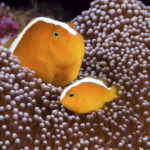
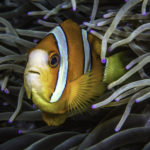
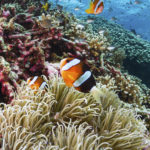

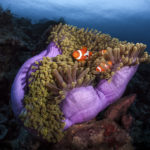
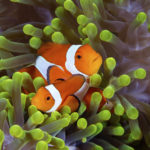

Don’t just fin by that clownfish
Unless they are snapping photos, most divers will pause for a look, then move on. But delving a little deeper into the particulars of the clownfish-anemone cohabitation reveals fascinating details. For starters, these fish are living in a dangerous environment. Anemones are closely related to jellyfish, with venom-filled tentacles that they use to sting and subdue passing fish. And yet, clownfish pass by and through these tentacles with seeming immunity. Hence, their other common name: the anemonefish. The simple explanation for this phenomenon is that a mucous layer coats the clownfish, rendering them immune to the stings. But that’s not the whole story.
There are some 30 species of clownfish, and while some sport a protective layer of slime, others must ease their way into a relationship with an anemone. This begins with an elaborate dance, with the clownfish gently touching the anemone with different parts of its body. The fish receives mild stings while building up immunity and developing a mucous coating. At the same time, the fish are adjusting their body chemistry to match the anemone’s, which no longer recognizes the fish as a meal. Once that happens, the anemone no longer has the impulse to sting.
A symbiotic relationship
Once they adapt to their host, clownfish enjoy excellent protection. Studies have shown that they have significantly higher survival rates than most species of free-swimming reef fish, provided that they stay near the stinging tentacles of their home. If caught in the open, clownfish are easy pickings for everything from moray eels to trumpetfish, scorpionfish, grouper and snappers. How far different species of clownfish will stray from their anemones varies based on their ability to get home.
Poorer swimmers such as the Percula clownfish and pink skunk clownfish rarely stray outside the anemone’s protective tentacles. They will quickly duck inside when a potential threat approaches. In contrast, more efficient swimmers such as the orange-fin and Clark’s anemonefish will venture out over three feet (a meter or more) from their host when foraging. Some species will actually come out and confront a threat to their eggs or the anemone. For example, if a diver comes too close to the anemone of a blue-stripe anemonefish, it may charge and attempt to bite. One quick way to tell if a clownfish will flee or fight is the shape of its tail fin. Generally speaking, the species with rounded tails will stick close, while the ones with notched tails are more likely to come out into the open.
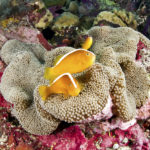
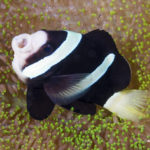
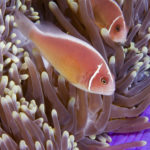
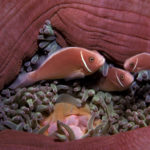
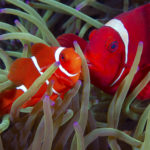
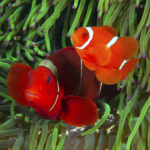
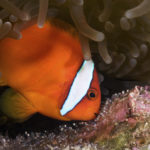
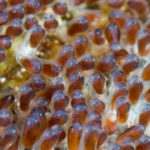
What does the anemone get?
So, what does the anemone get in return for providing protection for its resident clownfish? Scientists think that the fish provide janitorial services by swishing away and nibbling bits of debris that settle among the tentacles. But that’s just one service they provide. The clownfish’s movements help circulate oxygen-rich water among the tentacles. And, like corals, anemones cultivate crops of brown algae within their cells. The ammonium in clownfish poop nurtures these algae. A fish swimming about also helps expand the anemone’s tentacles, which allows the algae to receive more sunlight and produce more food for the anemone through photosynthesis. Researchers showed that when anemones did not have resident fish, they would shrink and sometimes die.
Some of the larger species of clownfish will also help protect their anemone from potential predators, such as butterflyfish, by emerging and aggressively confronting the attackers. On the Great Barrier Reef, when researchers removed the resident clownfish from bubble-tip anemones, most anemones were eaten within 24 hours. And when two-banded anemonefish were removed from the same species in the Red Sea, the Red Sea raccoon butterflyfish soon attacked the anemones.
Anemones that host clownfish aren’t just safer, they’re healthier and more likely to thrive and reproduce. A study of magnificent sea anemones showed that the ones harboring orange-fin anemonefish grew three times faster than those that did not have anemonefish present. Sea anemones with two or more anemonefishes in residence also had the highest fission rates — a form of asexual reproduction where the anemone basically splits in half to produce two sea anemones.
Now that you know a bit more about the fascinating partnership between these two very different animals, you may want to pause and take a closer look the next time you come across an anemone on a busy Wakatobi reef.
By guest author Karen Stearns
The post Wakatobi’s Perfect Pair: Clownfish and Anemones appeared first on Scuba Diver Life.
from Scuba Diver Life http://ift.tt/2C2r3la
No comments:
Post a Comment